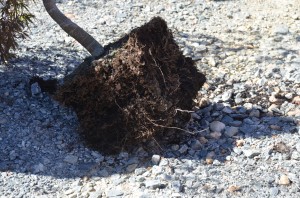When shopping at the garden center don’t bring home problem plants. “Plants On Sale” should raise a caution flag. Thoroughly inspect all sale plants. They may have been sitting many months with the pots now full of weeds, diseases, or pest problems. They become tightly potbound and roots will need to be teased apart prior to planting. Some of my worse garden weeds got their start from a purchased plant. Nutsedge and oxalis are two of worse to bring home.
Inspect the underside of leaves for bugs. If the pots are easy to lift weight-wise, pop the pot off and look for live roots. Root rot diseases like Photophtora and Pythium can seriously kill roots of holly, rhododendron, azaleas, junipers in containers.
Not all roots are white-colored, but should appear plump and moist. The potting soil (media) should not contain dry patches. The media has lost its ability to hold water (“hydrophobic”). If you’re purchasing 10 or more plants, inspect 2 to 3 items.
Once home, isolate all suspicious plants for 1-2 weeks prior to planting. Recent warnings about boxwood blight should raise your concern. Boxwood blight is primarily spread from newly purchased boxwoods that introduce the disease to an existing planting. Daylily rust is started in much the same matter. It is carried from new daylily purchases.
One final point! Some percentage of plant roots growing in black nursery containers may be dead. The side of the pot facing the sun (outside rows) is where to inspect. Black containers absorb excessive solar heat, usually on the west-facing side, and roots frequently die. When purchasing plants, select plants from inside and not on the edge of the block. Similarly, winter cold temperatures may kill roots on the exposed sides of overwintering containers.


 Posted in
Posted in 
